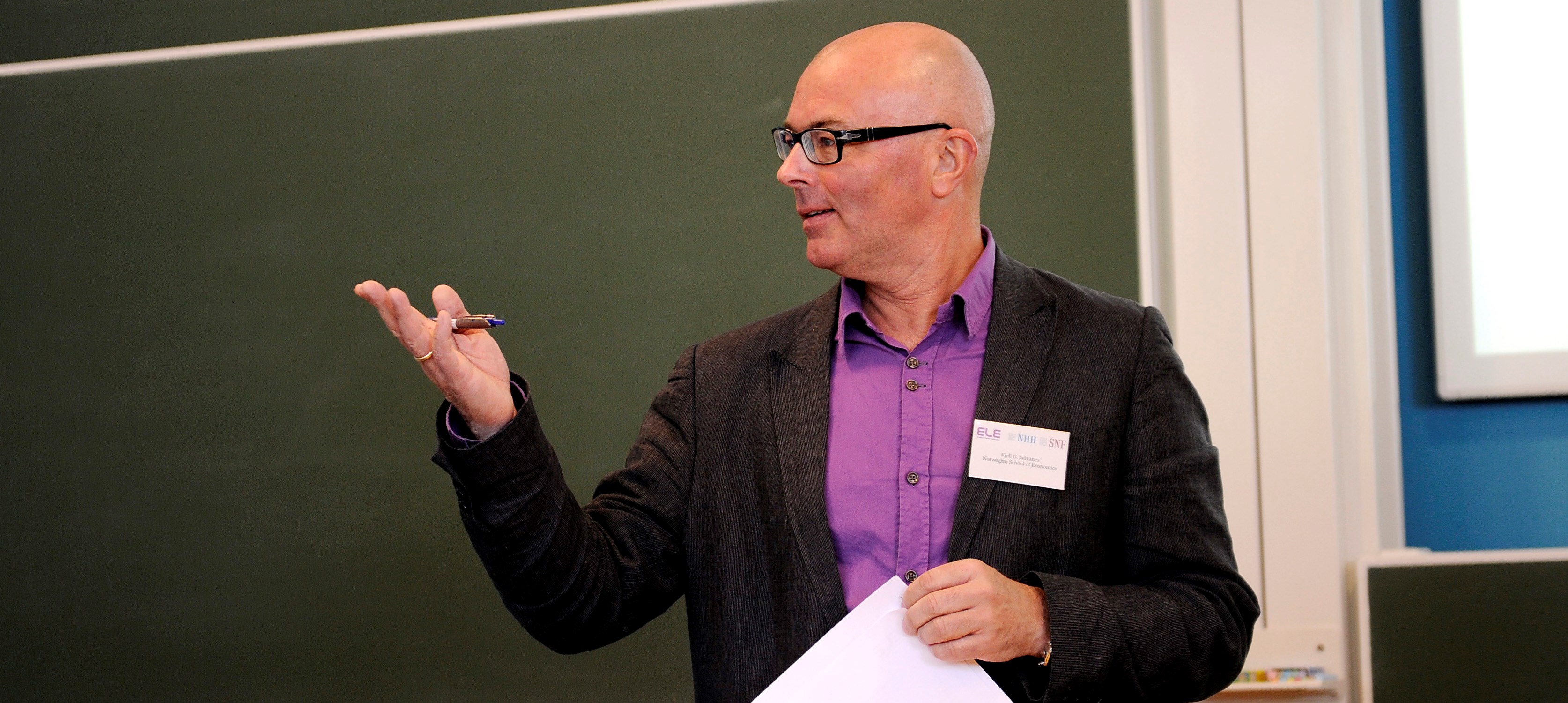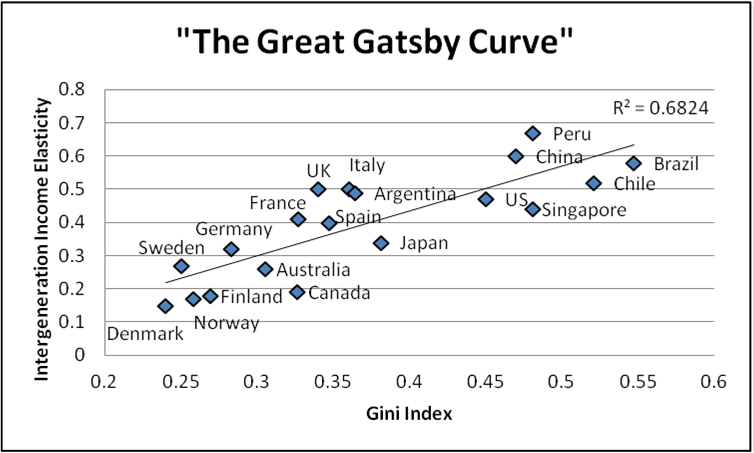New industries emerged that both required more education and paid well. As a result, parents may, for example, have seen that education yields a high return and therefore encouraged their children to take more education.
Professor Kjell G Salvanes

New research from NHH shows that, from the 1930s to the 1950s, Norway went from having low social mobility to becoming a world leader. Education really took off during the same period.
Today, social mobility is high in Norway. Parents' income does not decide children’s income to any great extent. Economic inequality is also very small compared with other developed countries.
This fits an international pattern where countries with low inequality often have high social mobility and vice versa. The curve that illustrates this is often called the ‘Great Gatsby curve’ after the novel with the same name (see illustration).

But why is that the case? Despite great and increasing interest in economic inequality, relatively little research has so far been conducted on social mobility.
In order to better understand social mobility and the importance of the welfare state in that context, Professor Kjell G Salvanes of NHH started by first obtaining an overview of the actual situation.
‘We find that social mobility measured by children’s and parents’ income in Norway increased dramatically right at the start of the period we are looking at, namely the period from 1930 to the early 1950s. After the 1950s, there is a flattening out. Social mobility stops increasing and stabilises at a high level,’ says Salvanes.

‘For Norway, this is the first study to go so far back in time,’ Salvanes says.
‘Previous research on social mobility has looked at people born in the early 1940s, while this study indicates that some of the most interesting developments took place in the decade before that.’
‘So the high mobility we see in Norway today has not always existed – it became established between the 1930s and 1950s. We reached the present level of social mobility around 1950. It was among the highest in the world at that time, and still is, at least compared with other Western countries,’ says Salvanes.
New industries emerged that both required more education and paid well. As a result, parents may, for example, have seen that education yields a high return and therefore encouraged their children to take more education.
Professor Kjell G Salvanes
Together with Tuomas Pekkarinen and Matti Sarvimäki of Aalto University in Finland, he has studied social mobility from the beginning of the 1930s until the mid-1970s. During this period, those whose parents earned least became more socially mobile.
The researchers also find that social mobility decreased among those whose parents earned most.
‘In the 1930s, there was huge upward mobility among sons of fathers who earned most, but this extra mobility had almost entirely disappeared by 1970. At the same time, mobility increased for those who earned least,’ says Salvanes.
At the same time as the big shift in income mobility, there was also a big shift in education. The average length of education increased dramatically from 1935 to 1950.
‘From the mid-1930s onwards, the Norwegian Labour Party carried out a regional educational reform, whereby the number of hours of education a week became the same in both town and country. We see a general increase in education and we see the rural areas catching up with the towns,’ Salvanes tells us.
The evolution of social mobility: Norway over the 20th century, by Tuomas Pekkarinen, Kjell G Salvanes and Matti Sarvimäki. Discussion paper, NHH Department of Economics.
Especially those for whom social mobility increased, such as the sons of fathers with low income, spend significantly longer in education than their parents.
‘The distribution of education in the population becomes more even. In earlier cohorts, it was much more necessary to have a high income in order to take higher education,’ Salvanes says.
At the same time as the general education level increases, the gap to the richest sons’ education level decreases. When education becomes more common, the return on it also falls.
The professor believes that the increase in education in the 1930s is one of the most important causes of the increase in social mobility, but he says that it is still unclear what caused this increase.
The eradication of tuberculosis was perhaps even more important. It was a widespread disease that was not just fatal, but also made people fatigued, so that it was difficult for them to attend school or work.
Professor Kjell G Salvanes
‘One possibility is that people chose to take more education as a result of normal economic forces. New industries emerged that both required more education and paid well. As a result, parents may, for example, have seen that education yields a high return and therefore encouraged their children to take more education,’ Salvanes continues.
An alternative explanation, in Salvanes’s opinion, could be the authorities’ push for more education. In Norway, it is easy to see this as an important factor because several reforms were implemented from the 1930s onwards that made education more accessible.
‘This is one of the key questions in the field,’ Salvanes tells us. ‘Is it the authorities or market forces that drive development?'
Because it is demanding to obtain good data so far back in time, there is little research to build on as yet. Salvanes believes that the truth lies somewhere in the middle.
‘There will always be more than one cause. Schools, for example, have to be accessible if people are to attend them,’ he says by way of illustration.
Salvanes is not in doubt, however, about the importance of the increase in education. People who lived in rural areas had 20 hours of schooling a week, compared with 40 hours a week in towns. After the 1930s reform, all pupils throughout the country had both a right and a duty to take the same number of hours.
‘They probably needed these extra hours to be able to catch up,’ says Salvanes.
‘That said,’ he adds, ‘it is still the case that parents’ education is a key factor in explaining children’s educational choices.’ In education, social mobility was much lower than was the case for income.
‘We thus have the slightly paradoxical situation that we have high social mobility when we look at income – much higher, for example, than in the USA – yet when we look at social mobility in education, it is surprisingly low.’ Even though the educational reforms were important to the levelling out that took place, they are not the whole story. To understand better why the intergenerational mobility in education is so low, is high up on the agenda for future research.
Nor were the Labour Party’s educational reforms the only development that took place in parallel with the increase in social mobility. The first Basic Agreement between the Norwegian Confederation of Trade Unions (LO) and NAF, one of the predecessors of today’s Confederation of Norwegian Enterprise (NHO), was signed in 1935, and the first national wage negotiations took place in the mid-1950s.
This contributed to a compressed wage structure that made it easier to move between the different income levels. Health reforms and an improvement in public health come in addition. In an ongoing project especially with associate professor Aline Butikofer at CELE (NHH) and with Katrine Løken at the University of Bergen, the role of early health reforms are being studied.
‘One factor, for example, is the opening of mother and child clinics, where new mothers could get help and advice. This proved very important to how much education people took and how much they earned later,’ Salvanes tells us.
‘The eradication of tuberculosis was perhaps even more important. It was a widespread disease that was not just fatal, but also made people fatigued, so that it was difficult for them to attend school or work.’
Internationally, there are figures for mobility dating back to around the 1950s, but it is demanding to go back in time because of the data material. You have to go to the archives, as we did here.
Professor Kjell G Salvanes
‘What role did the war play in this levelling out process?´
‘That’s a good question, and it is one of the factors we will consider when we go on to investigate the causal relationships in more detail. Fortunes may have disappeared during the war, and strict regulation could have dictated incomes. But there was undoubtedly a change before the war as well,’ Salvanes says.
So far, the researchers content themselves with affirming that there was increased income mobility, particularly at the beginning of the period, from the mid-1930s onwards.
The researchers have drawn on several data sources in their work. Norwegian register data provide a very good overview extending back to the 1960s, but to find records of personal income from before that time, they have had to use old analogue tax lists.
‘To find the incomes of the early cohorts, we linked the individuals’ occupations to figures for the average income of each occupation in the municipalities where they lived. This has been demanding pioneering work,’ Salvanes tells us.
‘Internationally, there are figures for mobility dating back to around the 1950s, but it is demanding to go back in time because of the data material. You have to go to the archives, as we did here.’
The researchers used three parameters to measure social mobility: the difference in the absolute incomes of father and son, the difference in income group between father and son, and the correlation between brothers’ incomes. These measures capture slightly different factors. The correlation between brothers, for example, captures a little more than the father-son correlation, such as neighbourhood, friends etc.